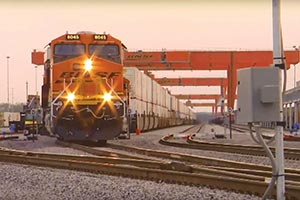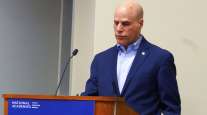Freight Facilities a Lure for Business, Planners Say

This story appears in the Jan. 16 print edition of Transport Topics.
WASHINGTON — Public officials who consider freight transportation of goods use that understanding to recruit business development.
Local and regional government planners at a Transportation Research Board session here Jan. 10 said their efforts often include 10-year projections on how to handle shipping, and that they know this information is of great importance to business executives who are considering where to locate facilities.
“Think about freight more than you have in the past,” urged Chris Gutierrez, president of KC SmartPort, the economic development corporation for the 18 Kansas and Missouri counties that make up metropolitan Kansas City.
“We compete against Columbus, Ohio, Indianapolis and Dallas,” Gutierrez said, so he pitches the four interstate highways that pass through Kansas City (I-29, 35, 49 and 70), railroad connections for commodities and intermodal and the Kansas City International Airport.
BNSF Railway helped, he said, by building its Logistics Park Kansas City intermodal facility with eight cranes that can lift 1.5 million containers a year.
In Savannah, Georgia, port officials started planning for the Panama Canal expansion about 10 years before the improved canal opened in 2016, said Walter Kemmsies, chief strategist for JLL Ports Airports and Global Infrastructure.
“In Savannah, every two years they revisit their 10-year plan,” he said of the port’s management, a JLL client. Kemmsies said Savannah made for a good case study of maritime preparations.
He criticized environmental review procedures for making improvements lengthy and difficult.
“In the mid-’90s expansion plans started, but dredging didn’t start until 2016. Our system has a ridiculous amount of friction,” he said.
Port expansion is highly complex, he said, as management must coordinate channel dredging, the installation of land-based cargo cranes, container yards, highways and rail facilities.
Development of a rail shuttle to the intermodal facility in Coverdele, Georgia, about 190 miles west of the port, was particularly important, he said, as it allows CSX Transportation and Norfolk Southern to handle a torrent of shipping containers without tying up precious port real estate.
The improvements in Savannah also were noted by Dina Lopez, a planner with the Mid-Ohio Regional Planning Commission, as Savannah to Columbus is a major rail shipping lane. Lopez spoke of her work on the Ohio capital’s Rickenbacker International Airport, which mainly handles airfreight and military aircraft.
“We don’t forget freight and what it means to our regional economy,” said Lopez, who also reminded the TRB audience to consider nontransportation infrastructure — even when trying to develop transportation.
Lopez said the commission is working to make sure freight facilities, including truck stops, have access to water and sewer, broadband Wi-Fi and electricity. She said the commission’s planning horizons often extend out 10 to 20 years.
The Quad Cities area straddling the Mississippi River in Illinois and Iowa approaches water transportation differently than does Savannah. For the Bi-State Regional Commission, the issue is barge traffic through a network of locks and dams, mainly for bulk commodities but containers could be an option soon.
Denise Bulat, the commission’s executive director, said the group’s first freight plan in 1989 considered container barges but found the idea would not work well, so riverboat gambling was constructed instead.
Nearly 30 years later, though, “We need a port, so maybe containers are feasible now,” Bulat said.
She also advised that engaging with local transportation executives is critical but can be difficult. Three-hour meetings on methodology will not attract such people, she said. Briefer meetings with an obvious connection to freight will work much better, Bulat said.




